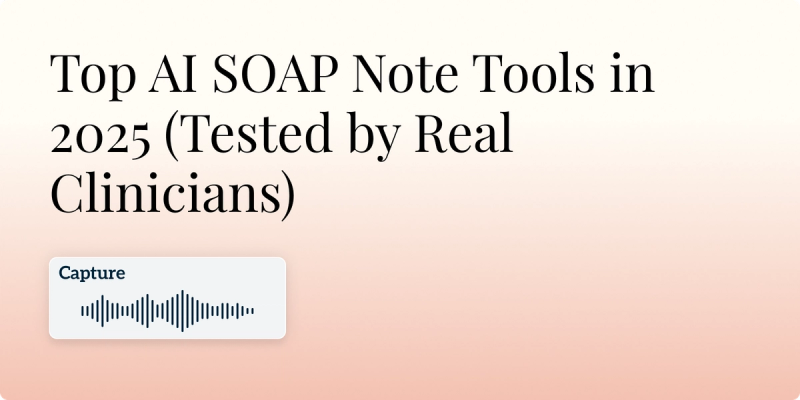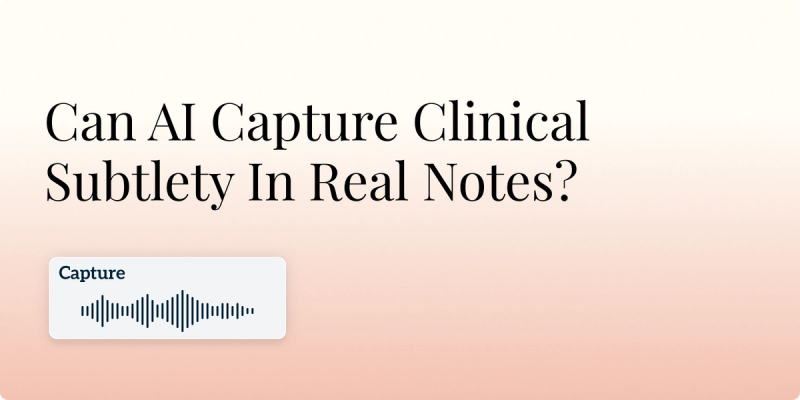
Can AI Notes Understand Therapy Work- Without Affecting The Relationship?

The therapeutic alliance is the core of effective mental health care, a sacred space built on trust, empathy, and human connection. Introducing technology, particularly artificial intelligence, into this dynamic naturally raises the question: Can AI genuinely comprehend the nuances of therapy work without damaging the bond that makes it effective?
The answer is not a simple yes or no. AI cannot and should not replace the clinician's understanding. Instead, the key lies in its role as an augmentative tool. Discover how AI therapy notes have the potential not to disrupt, but to preserve and even strengthen the therapeutic relationship by freeing the clinician to focus on what they do best: connecting with their patients.
The Core Challenge: Data vs. Meaning in the Therapeutic Space
At the heart of the debate is a distinction between processing data and interpreting clinical meaning. An AI model and a human therapist “listen” to a session in fundamentally different ways, and confusing these functions is where risk lies.
What AI “Hears”
AI operates on a data level. It processes linguistic input, identifying words, speech patterns, and statistical correlations. For instance, it might note that a “patient used the word ‘anxious’ five times in ten minutes, with a 20% increase in speech rate and a negative sentiment score”. It excels at recognizing these surface‑level, quantifiable patterns.
What the Therapist “Hears”
The therapist operates on a meaning level. They integrate the patients' words with a universe of non‑verbal data, such as:
- A sigh.
- Averted eye contact.
- A change in posture.
And contextualize it within the patient's history, personality, and the unfolding relational dynamic. They dont just hear “anxious”; they understand that the anxiety seems linked to an underlying fear of abandonment, which is currently being re‑enacted as resistance within the therapeutic hour itself.
The Technical Gap
The gap exists because AI models, such as Large Language Models (LLMs), are trained on vast datasets to predict the next most likely word in a sequence. They are masters of syntax and correlation, not of experience or empathy. They identify patterns in language, but they do not comprehend the human suffering, hope, or resilience behind those patterns. Acknowledging this limitation is the first step to using AI responsibly, framing it as a powerful assistant that handles data, freeing the clinician to focus on meaning.
How AI Therapy Note Taking Works: A Technical Breakdown
To build trust in the technology, it's crucial to break down the process. Modern therapeutic AI note‑taking is a multi-stage technical pipeline designed for accuracy and efficiency.
- Session Audio Capture: The process begins with the encrypted recording of the session audio within the HIPAA-compliant AI note tool. This step is never initiated without the patient's explicit, informed consent, which is a foundational ethical and legal requirement.
- Automatic Speech Recognition (ASR): The encrypted audio file is processed by an Automatic Speech Recognition engine. This technology converts spoken language into text. Advanced ASR systems used in healthcare are often fine-tuned on therapeutic vocabulary, allowing them to accurately transcribe complex terms like “attachment style” that general-purpose transcribers might miss.
- Natural Language Processing (NLP) Analysis: This is the core “intelligence” phase. The raw transcript is analyzed by an NLP model, which deconstructs the language to extract structured information. Key technical sub-processes include:
- Named Entity Recognition (NER): The model identifies and categorizes specific entities mentioned, such as people (“my partner, Alex”), locations (“my office downtown”), or medications (“my dosage of Sertraline”).
- Topic Modelling: Using algorithms like Latent Dirichlet Allocation (LDA), the AI identifies and clusters the main themes discussed throughout the session (e.g., “work stress”, “family conflict”, “sleep hygiene”)
- Sentiment Analysis: The model assesses the emotional tone of the conversation, typically scoring it on a scale (e.g., positive, negative, neutral) to provide an objective measure of affective content.
- Structured Note Generation: Finally, the insights from the NLP analysis are used to populate a structured note template selected by the therapist, such as SOAP (Subjective, Objective, Assessment, Plan) or DAP (Data, Assessment, Plan). The AI drafts the “Subjective” section from the patients' quotes, the “Objective” from observed themes and sentiments, and may even suggest potential “Assessment” points based on the discussed topics. The output is a comprehensive, well-organized draft, not a final clinical note.
Enhancing, Not Replacing: The Path to a Stronger Alliance
When implemented with care, AI in therapy work does not intrude upon the therapeutic relationship; it can become its guardian. The true potential of this technology lies in its ability to handle administrative burdens, allowing the therapist to fully embody their irreplaceable human role. By strategically automating tasks, AI therapy notes can contribute to a stronger, more focused therapeutic alliance.
Reducing Administrative Burden
- The Problem: The admin overload is a primary driver of therapist burnout. Spending 1-2 hours on notes for every clinical hour leads to cognitive overload and fatigue, directly impacting a clinician's capacity for connection and empathy.
- The AI Solution: By automating the drafting of session notes, AI gives therapists their most valuable resources back: time and mental energy. A clinician who is freed from hours of paperwork is less likely to experience burnout. This directly benefits the patient, as a less-stressed therapist is more available, attuned, and emotionally present during sessions, creating a more supportive environment.
Increasing Session Presence
- The Problem: The physical act of note-taking, whether on a keyboard or notepad, inevitably creates moments of broken eye contact and divided attention. This can disrupt the flow of a session and subtly communicate that the task of documentation is competing with the person in the room.
- The AI Solution: With AI as a silent scribe, the therapist can engage in true deep listening. They can maintain consistent eye contact, observe subtle non-verbal cues, and respond with greater empathy and timing. This undivided attention is a powerful, non-verbal communication of respect and care, strengthening the therapeutic relationship with AI acting as an invisible support.
Providing Data-Driven Insights
- The Problem: Human memory is subjective and fallible. Subtle shifts in a patient's narrative can be difficult to track objectively across multiple sessions.
- The AI Solution: AI therapy notes can analyze language patterns over time. Providing objective, data-driven insights. For example, the tool could generate a simple timeline chart showing the frequency of keywords like “hopeless” or “confidence” over 10 weeks. This allows the therapist and patient to collaboratively visualize progress, identify stuck points, and ground the therapeutic work in tangible evidence.
The Non-Negotiables: Ethical and Effective Implementation
For AI in therapy work to be beneficial, it must be built and used within a rigid ethical framework. The following safeguards are non‑negotiable for any practice considering this technology.
- Informed Consent is a Must: Patients must provide explicit, informed consent before any session is recorded. They need a clear understanding of how the AI is used, how their data is encrypted and stored, and they must always have the right to opt out without any penalty to their care.
- Therapist as Final Editor: The AI generates the draft, not the final record. The therapist bears the ultimate responsibility to review, edit, correct, and imbue the note with their clinical judgment. The final note is a product of human expertise, with AI as an efficiency tool.
- Data Security and HIPAA Compliance: All data, both audio and text, must be encrypted in transit and at rest. The AI provider must be a fully HIPAA-compliant Business Associate with signed agreements in place, ensuring they are legally bound to protect patient health information.
- Transparency: Therapists should break down the technology for patients. Explain that it is an assistive tool for documentation. This honesty builds trust and manages expectations around the role of AI in therapy work.
Conclusion
Ultimately, AI cannot “understand” therapy in the human, empathetic sense. However, when implemented ethically and used as a tool to augment the therapist's skills, it can significantly reduce burnout and increase session presence. This strategic partnership allows technology to handle the data, so the clinician can focus on the meaning. By removing administrative barriers, AI therapy notes protect and strengthen the most crucial element of it all: the human‑to‑human therapeutic relationship with AI as a silent, efficient partner.
Frequently Asked Questions
ABOUT THE AUTHOR
Dr. Danni Steimberg
Licensed Medical Doctor
Reduce burnout,
improve patient care.
Join thousands of clinicians already using AI to become more efficient.

How To Save Hours On Soap Notes Without Losing Clinical Detail
Tired of SOAP notes stealing your time? Learn how AI helps you document faster and more thoroughly, ensuring no clinical detail is lost.

Top AI SOAP Note Tools in 2025 (Tested by Real Clinicians)
Discover Top AI SOAP Note Tools in 2025 - tested by real clinicians. Compare accuracy, EHR integrations, HIPAA/BAA, pricing, and use cases to pick the best fit.

Can AI Capture Clinical Subtlety In Real Notes?
Exploring whether AI can interpret the subtleties in clinical notes, bridging the gap between data and human medical expertise.

